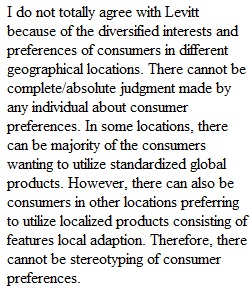


Q 1. Watch the video on international strategy. 2. Nowadays, MNCs usually have a standardized global strategy, but local execution. This ensures that the local needs and preferences are met and respected, while the company's overall global strategies are met. With the rapid globalization in the 1970s & 1980s, the success of global companies created and strengthened several countervailing forces of localization. Governments started to demand that global companies invest locally, transfer technologies, and meet local content requirements. Also, customers contributed to these forces by rejecting standardized global products, and demanded that their local requirements be met. In addition, the rapid fluctuations in currency exchange rates undermined a centralized global approach (Bartlett & Ghoshal, 2000); this is known as a Transnational Strategy. Generally, companies should try to respond to specific local market needs, while avoiding compromising the overall global operation's efficiency (Bolt, 1988). Levitt (1983) mentioned that due to technology diffusion and global communications, consumer preferences are the same everywhere and that markets are globalized. Do you agree or disagree with Levitt? And why? What the pros and cons of global standardization vs. adaptation? Bartlett, C.A. & Ghoshal, S. (2000). Transnational management (3rd ed.). New York, NY: McGraw-Hill Bolt, J. F. (1988). Global Competitors: Some criteria for success. Business Horizons, 31(1), 34 – 41. Levitt, T. (1983). The globalization of markets. Harvard Business Review, 61(3), 92 – 102
View Related Questions